Git Tutorial 教學
- 2. Agenda ‧什麼是「版本控制系統」 ‧Git 簡介 ‧Git 內部原理 ‧Git 指令 ‧Git 開發模式及流程 ‧更多 GitTips ‧GitHub 簡介 2
- 3. 3 我是誰? • 張⽂文鈿 a.k.a. ihower • http://ihower.tw • Faria Systems, CTO • The founder of RubyConfTaiwan • http://rubyconf.tw
- 4. 我的版本控制之路 ‧2002 ⺫⽬目錄管理法 (定時 copy 備份⼀一次) ‧2005 SubVersion ‧2007 SVK ‧2008 Git (像 SVN ⼀一樣只會 push/pull) ‧2009 Git (主要還是在 master 開發,有⼤大功能才會開 feature branches) ‧2011 Git (根據 git flow,做任何事幾乎都開 topic branch。⼤大玩 rebase) 4
- 5. 1. 版本控制系統 5
- 9. Version Control System (VCS) ‧建⽴立 Repository (儲存庫),⽤用來保存程式碼 ‧⽅方便散佈程式給團隊,有效率協同開發 ‧記錄誰改變什麼、在什麼時候、因為什麼原因 ‧Branch(分⽀支),可因不同情境分開開發 ‧Tag(標籤) 重要⾥里程碑,以便參照 9
- 10. Repository 存什麼? ‧所有跑起來這個專案需要的東⻄西 –所有原始碼、範例設計檔、⽂文件等等 –暫存檔、log 檔案、build files 等編譯後的產物 則不需要存進 Repository 10
- 11. LocalVCS copy paste 資料夾管理, rcs 11 ⼯工作⺫⽬目錄: 檔案 版本資料庫 ! ! ! ! ! ! ! Version 2 Version 1 Version 3 copypaste }Local 無法協同開發
- 12. CentralizedVCS (Lock型,悲觀鎖定) 12 電腦 A 檔案 電腦 B 檔案 中央版本資料庫 ! ! ! ! ! ! ! Version 2 Version 1 Version 3 commitlock and checkout }Server }Local 雖然可以避免衝突,但是很不⽅方便。 其他⼈人得排隊,萬⼀一先取出的⼈人寫很久或 忘記 unlock...
- 13. CentralizedVCS (Merge型,樂觀鎖定) CVS, Subversion, Perforce 13 電腦 A 檔案 電腦 B 檔案 中央版本資料庫 ! ! ! ! ! ! ! Version 2 Version 1 Version 3 commitcheckout }Server }Local 1. 做什麼事都要跟 伺服器連線,很慢。 2. Single point of failure
- 14. DistributedVCS Git, Mercurial(Hg), Bazaar 149 Computer A 檔案 版本資料庫 ! ! Computer B 檔案 版本資料庫 ! !Version X Version Y 版本資料庫 ! ! ! ! ! Version Y Version X commitcheckout pushpull }Server }Local 多種 workflow ⼤大放異彩!
- 15. Local development ‧集中式的VCS 系統,沒網路就不能開發, 無法 commit,無法看 history log。 –坐⾼高鐵,坐飛機的時候 –網路故障的時候 –咖啡店沒有無線網路的時候 ‧分散式 CSV 系統即使沒網路,照常可以 commit 和看 history log。 ‧不⽤用擔⼼心server備份 15
- 16. 2. Git 簡介 16
- 17. Git ‧開放源碼的分散式版本管理系統(DVCS) ‧發明⼈人 LinusTorvalds (Linux creator) ‧⺫⽬目的是管理 Linux Kernel 原始碼 ‧2005/4 開始開發,2005/6 開始管理 Linux Kernel,2005/12 釋出 1.0 版 17
- 18. 誰在⽤用 Git? ‧Git ‧Linux Kernel ‧Perl ‧Eclipse ‧Gnome ‧KDE 18 ‧Qt ‧Ruby on Rails ‧Android ‧PostgreSQL ‧Debian ‧X.org
- 19. Why Git is Better than X http://thkoch2001.github.io/whygitisbetter/ ‧便宜快速的本地分⽀支 ‧所有內容都在本地端 ‧Git 很快 ‧Git 很省空間 ‧Staging 功能 ‧它是分散式的 ‧適⽤用任何⼯工作流程 ‧我們有 GitHub!
- 20. 傳統 Delta 儲存⽅方式 記錄每次檔案變更,開分⽀支需要建⽴立副本。 20 delta storage file A Δ1 file B file C C1 C2 C3 C4 C5 Δ2 Δ1 Δ2 Δ1 Δ2 Δ3
- 21. DAG 儲存⽅方式 (DAG: Directed acyclic graph) 利⽤用有向無環圖來記錄 metadata 建構出 snapshots 。 相同內容只會有⼀一份記錄。 21 A B C C1 C2 C3 C4 C5 A1 B C1 A1 B C2 A2 B1 C2 A2 B2 C3 snapshot storage I’m a mini filesystem! Not just VCS. 延伸應⽤用: 可當做備份儲存格式
- 22. 22
- 24. 24
- 27. Git SHA1(demo) ‧echo sweet > sweet.txt ‧git add . ‧find .git/objects -type f ‧Git 內部儲存在 .git/objects/aa/ 823728ea7d592acc69b36875a482cdf3fd5c8d ‧這是 "blob" SP "6" NUL "sweet" LF 的 SHA1 ‧printf "blob 6000sweetn" | shasum –或 echo 'sweet' | git hash-object -w --stdin ‧git cat-file -p aa823728ea7d592acc69b36875a482cdf3fd5c8d 27 http://www-cs-students.stanford.edu/~blynn/gitmagic/ch08.html
- 28. Git is ContentTracker ‧Git is content-addressable filesystem ‧SHA1 是根據內容產⽣生的,跟檔名無關 –內容⼀一樣的檔案,可以 reuse,例如 revert 的情況 –解耦合(decouple)了內容與當時的檔名 ‧Git 有四種 Objects 記錄內容:Blob、Tree、 Commit、Tag 28
- 30. Blob 記錄檔案內容 30 Rakefile README simplegit.rb ./ lib/ blob : a874b7 blob : a906cb blob : a0a60a Working Directory Git Directory
- 31. Tree 記錄該⺫⽬目錄下有哪些檔案(檔名、內容的SHA1)和Trees 31 Rakefile README simplegit.rb ./ lib/ tree : 1a738d tree : fe8971 Working Directory Git Directory blob : a874b7 blob : a906cb blob : a0a60a
- 32. Commit 記錄 commit 訊息、Root tree 和 Parent commits 的 SHA1 32 Rakefile README simplegit.rb ./ lib/ tree : 1a738d tree : fe8971 Working Directory Git Directory blob : a874b7 blob : a906cb blob : a0a60a commit : a11bef
- 33. Object DAG Example 33 commit tree blob tree tree blob blob
- 34. Trace Git commit (demo) ‧隨便抓⼀一個 Commit 的 SHA1 開始: –git cat-file -p a08181bf3 (觀察這個 commit,找出 tree 位置 ) –git cat-file -p ea44d629 (觀察這個 tree,找出任⼀一個 blob SHA1) –git cat-file -p d9647d8a (觀察這個 blob 的內容) 34
- 36. 參照 refs ‧Reference 會指向⼀一個 Commit ‧tag 不會移動,指向的 commit 都⼀一樣 –(帶有額外資訊的 tag 內部會⽤用 Object 儲存) ‧branch 指向該 branch 最新的 commit ‧HEAD 指向 current branch 36
- 37. Reference is cheap! ‧開新 branch 和 tag 只不過是 refs ⽽而已,直 到真的有 commit 前都沒有什麼負擔 ‧不像有些 CSV 開分⽀支會複製⼀一份原始碼, ⾮非常耗費資源 37
- 38. Integrity ‧SHA1 是內容的 checksum ‧Integrity: 如果檔案內容有損毀,就會發現跟 SHA1不同。如果 tree 改檔名,也會被發現。 ‧這在分散式系統⾮非常重要:資料從⼀一個開發者 傳到另⼀一個開發者時,確保資料沒有被修改 38
- 40. Trace Git branch (demo) ‧cat .git/HEAD 拿到⺫⽬目前⼯工作⺫⽬目錄 current branch 是指向哪⼀一個 branch ‧cat .git/refs/heads/master 拿到 master branch 指向的 commit ‧cat .git/refs/tags/foobar 拿到 foobar tag 指向的 commit 40
- 41. Object DAG Full Example 41 commit tag tree blob tree tree commit tree blob tree tree blob commit 3 tree blob blob branch HEAD tag commit 2commit 1
- 42. ⾃自從⽤用了 Git,就再也不會想⽤用 SVN 了 ‧svn 開分⽀支和 merge 超痛苦,能避免開 branch 就避免開 branch ‧svn 看 log 超痛苦,需要等待網路連線 ‧svn commit 或 checkout 超慢,主機放國外 常 commit ⼀一半中斷 42
- 43. 4-1. Git 指令基礎 43
- 44. Git is a collection of command-Line utilities 44
- 45. Install Git ‧安裝 Git – http://help.github.com/set-up-git-redirect ‧安裝 Git GUI(optional) –GitX (Mac) –TortoiseGit/Git Extensions (Windows) –gitq, gitk (Linux) 45
- 46. Setup ‧編輯 ~/.gitconfig 或輸⼊入以下指令 ‧git config --global user.name "Your Name" ‧git config --global user.email "[email protected]" ‧git config --global color.ui true ‧git config --global core.editor "vi" 46
- 47. Setup (Windows only) ‧處理換⾏行字元誤認為變更 ‧git config --global core.autocrlf true ‧git config --global core.safecrlf true 47
- 48. 從頭建⽴立 Repository (demo) ‧mkdir sandbox ‧cd sandbox ‧git init 48
- 49. 第⼀一次 commit (demo) ‧touch README ‧git add README ‧git status ‧git commit -m “First Commit” 49
- 50. 修改看看 (demo) ‧編輯 README 做些變更 ‧git status ‧git diff ‧git add . (⼀一次加⼊入所有變更跟新增檔案,但不包括刪除的檔案!) ‧git status ‧git diff --cached ‧git commit -m “Update README” 50
- 51. 三種區域:Working tree/Staging Area/Repository 51 git directory (repository) staging area working directory git add git commit git checkout
- 52. Working tree 裡的檔案有四種狀態 52 git directory (repository) staging area working directory git add git commit Untracked files Changes not staged for commit Changes to be committed Commtted
- 53. Why? Staging Area ‧Working tree 可能很亂,包含了想要 commit 的內容和不相關的實驗修改等 ‧Staging area 的設計可以讓你只 commit 想要 的檔案,甚⾄至是想要的部份修改⽽而已 ‧Staging Area ⼜又叫作 Index 53
- 54. 只 commit 部分檔案 (demo) 54 ‧touch a.rb ‧touch b.rb ‧git add a.rb ‧git commit “Update a” ‧git add b.rb ‧git commit “Update b”
- 55. staging 之後⼜又再修改內容 (demo) ‧修改 a.rb ‧git add a.rb ‧再次修改 a.rb ‧git commit -m “commit a” –這時 commit 的內容是第⼀一次修改當時的內容 ⽽而已 55
- 56. 只 commit 同⼀一檔案部分內容 (demo) ‧git add --patch –y 加到 staging –n 不要加到 staging –s 可以拆⼩小⼀一點 hunk ‧或者⽤用 GUI 例如 gitx 來選取 56
- 57. 在 commit 之前如何復原修改? (demo) git directory (repository) staging area working directory git reset git checkout Changes not staged for commit Changes to be committed Commtted (未修改前)
- 58. 刪除和搬移檔案 (demo) ‧git rm a.rb ‧git mv b.rb c.rb ‧git add . ‧git commit “Remove a, Rename b to c” ‧沒有 copy ? 因為 Git 是追蹤內容(相同內容SHA1相同), 你只要 cp 即可,不⽤用擔⼼心浪費空間。 58
- 59. revert (還原 commit 記錄) ‧新增⼀一筆 commit 來做還原 –例如本來的 commit 是新增⼀一⾏行,那麼 revert commit 就會移除那⼀一⾏行 ‧git revert e37c75787 ‧git revert HEAD^ 59
- 60. 下標籤 (demo) ‧git tag foo ‧git tag foo <SHA1> ‧git tag bar -m “some message” ‧git tag ‧git tag -d foo 60
- 61. 歷史紀錄 ‧git log ‧git log --oneline ‧git log --oneline --decorate --graph ‧git log 很多參數可以⽤用,但是建議還是⽤用 GUI 吧... 61
- 62. ⽐比較差異 Diff ‧git diff <SHA1> 拿 WorkingTree ⽐比較 ‧git diff <SHA1> <SHA1> ‧git diff --stat <SHA1> ‧git diff --cached 或 git diff --staged 拿 Staging Area 來⽐比較 62
- 63. 砍掉 untracked 檔案 (demo) ‧git clean -n 列出打算要清除的檔案 ‧git clean -f 真的清除 ‧git clean -x 連 gitignore 裡列的檔案也清掉 63
- 64. 忽略不需要追蹤的檔案 ‧編輯 .gitignore (屬於專案的設定,會 commit 出去) ‧編輯 ~/.gitignore (你個⼈人的 Global 設定) ‧空⺫⽬目錄不會 commit 出去,必要時需要 放 .gitkeep 檔案 ‧.gitignore ⼤大集合 https://github.com/github/gitignore 64
- 65. 通常什麼檔案 不需要 commit 出去? ‧tmp/* ‧log/* ‧你個⼈人環境的設定檔(例如你偏愛的編輯器設定檔) ‧可以⾃自動產⽣生的檔案 ‧build/* 等 compile 之後的檔案 ‧.DS_Store ‧Thumbs.rb 65
- 66. Commit 基本原則 ‧適當的粒度/相關性/獨⽴立性 –以⼀一個⼩小功能、⼩小改進或⼀一個 bug fixed 為單位。 –對應的 unit test 程式在同⼀一個 commit –無相關的修改不在同⼀一個 commit –語法錯誤的半成品程式不能 commit ‧git diff --check 可以檢查多餘的空⽩白 ‧commit 訊息很重要 –第⼀一⾏行寫摘要 –有需要寫實作細節的話,放第⼆二⾏行之後 66 http://www.freshconsulting.com/atomic-commits/
- 68. 何時開 Branch ? ‧Topic feature 開發新功能 ‧Bug fixes ‧重構 (refactor) ‧任何實驗 68
- 70. (master) git branch iss53 70 C1C0 C2 master iss53
- 71. (iss53) git commit 71 C1C0 C2 master iss53 C3
- 72. (master) git branch hotfix (hotfix) git commit 72 C1C0 C2 master iss53 C3 C4 hotfix
- 73. (master) git merge hotfix 73 C1C0 C2 master iss53 C3 C4 hotfix 這種只需要改變參 考的合併叫作 fast-forward
- 74. (iss53) git commit 74 C1C0 C2 master iss53 C3 C4 C5
- 75. (master) git merge iss53 75 C6 是個 merge commit (會有兩個 parent commits) C1C0 C2 master iss53 C3 C4 C5 C6
- 76. 開 branch (demo) ‧git branch new_feature ‧git branch 或 git branch <SHA1> ‧git checkout new_feature –(以上兩步可以合⼀一 git checkout -b new_feature) ‧touch new_feature.rb ‧git add new_feature.rb ‧git commit -m “New feature” 76 ⽤用 checkout 切換分⽀支,同 ⼀一時間你的 working tree 只 能待在⼀一個分⽀支下
- 77. 合併 branch 回來 (demo) ‧git checkout master ‧git merge new_feature 77
- 78. Merge CONFLICT 怎麼辦? ‧git status 看哪些檔案有 conflict ‧⼿手動編輯這些檔案,解決 <<<<< ===== >>>>>> 有衝突的部分 ‧或是 git mergetool ⽤用⼯工具解決 ‧git reset HEAD --hard 放棄合併 78 git reset HEAD --hard 超好⽤用,可將 working tree 全部復原
- 79. Branch 更名和刪除 ‧git branch -m old_name new_name ‧git branch -M old_name new_name (強制覆蓋) ‧git branch new_feature -d ‧git branch new_feature -D (強制刪除) 79
- 80. 四種合併⽅方式 ‧Straight merge 預設的合併模式 –保留被合併的 branch commits 記錄,並 加上⼀一個 merge commit,看線圖會有兩 條 Parents 線。 –如果是 fast-forward,就不會有 merge commit。除⾮非加上 --no-ff 參數。 80
- 81. 四種合併⽅方式 (cont.) ‧Squashed commit –git merge new_feature --squash –壓縮成只有⼀一個 merge-commit,不會有被合併 的 log。SVN 的 merge 即是如此。 ‧cherry-pick –git cherry-pick 714cba –只合併指定的 commit –-x 參數會在 log 裡加注本來是哪個SHA1 (適合 ⽤用在 backpointing 情境) 81
- 82. 使⽤用 branch 注意事項 ‧切換 working tree 的 branch 時,如果有檔案 在 staging area 或是 modified,會無法切換。 ‧可以先 commit,反正只要不 push 出去,再 reset 回來即可 ‧或是⽤用 stash 指令暫存起來 –git stash –git stash apply –git stash clear 82
- 83. Branches 當做存檔(savepoint) ‧git branch is cheap! ‧建⽴立 branch 即可保留當時的 Graph ‧就像遊戲存檔 83
- 84. 安全合併法: Scout way ‧先建⽴立⼀一個 test_merge ‧git checkout -b test_merge ‧git merge XXX ‧不喜歡就重來 ‧如果喜歡就回 git checkout master ‧git merge test_merge 此時會 fast-forward 84
- 85. 安全合併法: Savepoint way ‧git branch savepoint ‧git merge XXX ‧git branch -d savepoint ‧如果不喜歡想重來 –git reset savepoint --hard 85
- 86. 無名 Branch 狀態 ‧git checkout <branch_name> 前往特定 Branch ‧git checkout <SHA1> 則會前往特定節點,此 時會是 detached HEAD 狀態,⼀一種沒有名字 的 current branch 狀態 ‧git checkout -b new_branch 就會給⼀一個名字 86
- 87. 什麼是 Three-way merge ‧two-way merge 只⽤用兩個檔案進⾏行合併 (svn 預設即 two-way merge) ‧three-way merge 除了要合併的兩個檔案, 還加上兩個檔案的共同祖先。如此可以⼤大 ⼤大減少⼈人為處理 conflict 的情況。 87http://en.wikipedia.org/wiki/Merge_(revision_control)
- 88. Git merge strategy ‧recursive,當共同的祖先不只⼀一個 commits 時,遞迴式的進⾏行 three-way merge (此為預 設) –git merge foobar -s recursive -X ours –git merge foobar -s recursive -X theirs ‧resolve,直接挑⼀一個共同的祖先進⾏行 three- way merge ‧octopus,當合併超過兩個以上的 branchs 時 ‧ours,只⽤用⾃自⼰己的 branch 的 commits ‧subtree 合併成⼀一個⼦子⺫⽬目錄 88
- 89. Git 可以⼀一次合併多個 Branchs git merge A B C 89 http://stackoverflow.com/questions/ 366860/when-would-you-use-the- different-git-merge-strategies
- 91. 以 GitHub Repository 為例 建⽴立⼀一個專案! ‧產⽣生 SSH Key –ssh-keygen -t rsa -C "[email protected]" ‧⾄至 Github 開⼀一個專案 ‧git remote add origin [email protected]:your_account/ sandbox.git ‧git push -u origin master ‧之後只需要 git push –出現 ![rejected] 表⽰示需要先做 git pull 91
- 92. 拷⾙貝從⼀一個已經存在的 Repository ‧SSH 安全性最佳 –git clone [email protected]:ihower/sandbox.git ‧HTTP/HTTPS 速度最差,但能突破防⽕火牆限制 –git clone https://[email protected]/ihower/sandbox.git ‧ Git protocol 速度最快,但缺認證機制(因此只能做成唯讀) –git clone git://github.com/ihower/sandbox.git ‧File 本機⺫⽬目錄 (有⼈人⽤用 Dropbox 分享 git init --bare --shared ⺫⽬目錄!! Crazy!!) –git clone file://path/to/repo.git 92
- 93. Clone 別⼈人的專案 ‧如果有讀寫權限,使⽤用 SSH 協定 –git clone [email protected]:ihower/sandbox.git ‧如果只有讀取權限,使⽤用 Git 協定 –git clone git://github.com/ihower/sandbox.git ‧如果有防⽕火牆問題,⽤用 HTTPS 協定 –git clone https://github.com/ihower/sandbox.git 93
- 94. Pull 從遠端更新 ‧git pull origin master 或 git pull –實際作⽤用是先 git fetch 遠端的 branch –然後與本地端的 branch 做 merge,產⽣生⼀一個 merge commit 節點 94
- 95. Push 將 Commit 送出去 ‧git push 或 git push origin master –實際的作⽤用是將本地端的 master branch 與遠端 的 master branch 作 fast-forward 合併 ‧如果出現 [rejected] 錯誤的話,表⽰示你必須 先作 pull。 ‧預設不會 push tags 資訊 –git push --tags 95
- 96. 列出和取出遠端 branch ‧git branch -r ‧git checkout -t origin/foobar ‧git branch -r --merged (列出已經被合併的) 96
- 97. 刪除遠端 Branch ‧git push origin :foobar ‧git pull 和 git fetch 不會清除已經被刪掉的 branch –請⽤用 git fetch -p 97
- 98. 4-4. Git 指令:還沒 push 前可以 做的事 98
- 99. 還沒 push 分享出去的 branch,你 可以... ‧不同於 SVN,Git 的 Commit 其實還在本地 端,所以可以修改 commit logs!! –修改 commit 訊息,甚⾄至內容 –合併 commits –打散 commit 成多個 commits –調換 commits 順序 99
- 100. reset (回到特定節點) ‧跟 revert 不同,reset 是直接砍掉 commits 歷史記錄 ‧git reset e37c75787 ‧git reset HEAD^ (留著修改在 working tree) ‧git reset HEAD^ --soft (修改放到 staging area) ‧git reset HEAD^ --hard (完全清除) 100
- 101. 其實剛剛的安全合併法 savepoint way 不需要建⽴立 branch ‧直接 git reset <SHA1> --hard 即可 ‧branch name 只是 reference 101
- 102. 快速修正上⼀一個 Commit ‧上⼀一個commit有typo,想要重新commit –git reset HEAD^ –修正 –git commit -am “message” ‧可以簡化成 –修正 –git commit -a --amend 102
- 103. rebase (重新 commit ⼀一遍) ‧git rebase -i e37c7578 103 pick 048b59e first commit pick 995dbb3 change something pick aa3e16e changed ! # Rebase 0072886..1b6475f onto 0072886 # # Commands: # p, pick = use commit # r, reword = use commit, but edit the commit message # e, edit = use commit, but stop for amending # s, squash = use commit, but meld into previous commit # f, fixup = like "squash", but discard this commit's log message # x, exec = run command (the rest of the line) using shell # # If you remove a line here THAT COMMIT WILL BE LOST. # However, if you remove everything, the rebase will be aborted.
- 104. rebase is dangerous!! It rewrite history! 104 But I like it!
- 105. 第四種合併⽅方式: rebase ‧rebase 調整分⽀支點 (僅適⽤用於 local branch) –1. 從要被合併的 branch 頭重新分⽀支 –2. 將⺫⽬目前 branch 的 commits 記錄⼀一筆⼀一筆重新 apply/patch 上去 –等於砍掉重練 commit log,僅適合還沒分享給 別⼈人的 local branch。 105
- 106. ⼀一個範例: 開發中的 new_feature 想要合併 master 主幹的變更 106 A B C new_featureD master E F
- 107. 如果是 merge (new_feature) git merge master 107 A B C new_feature D master E F G
- 108. 如果⽤用 rebase,就沒有 G 點! (new_feature) git rebase master 108 ⽤用這招可以不產⽣生分⽀支線和 merge commit A B C new_feature D` master E`F
- 109. rebase notes ‧注意到 D` 和 E` 和本來的 D 和 E commits 已經被視為不同 commit,SHA1也不同了 ‧rebase 過程中,每⼀一次 apply 都有可能發⽣生 conflict,跟 merge 只發⽣生⼀一次不同。 ‧發⽣生 conflict 怎麼辦? 可以選擇修好後 continue, 忽略 skip 或放棄 abort –記得⼀一定要離開 rebase 的 context 情境 109
- 110. 110 已經 push 分享出去的 commits 記錄,請千萬不要再修改記錄 push 出去!!
- 111. 集⼤大成: rebase + merge 的 完美 合併法 (假設我們要將 feature branch 合併回主幹 develop) ! ‧原因 –feature branch 很亂,不時 merge 與主幹同步 –feature branch 有 typo,commit 訊息想改 –feature branch 有些 commits 想合併或拆開 ‧作法 –先在 feature branch 做 git rebase develop -i –(反覆整理直到滿意) git rebase 分岔點 -i –在從 develop branch 做 git merge feature --no-ff 111 ⻱⿔龜⽑毛
- 115. Demo (rebase + merge) 115
- 116. 注意事項 (1) ‧必須要加 --no-ff 才會有 merge commit。不 然會是 fast-forward。 ‧rebase 之後的 feature branch 就不要再 push 出去了 ‧如果有遠端的 feature branch,合併完也砍 掉 116
- 117. ‧不求⼀一次 rebase 到完美,不然中間的 conflict 會搞混。 ‧可以⼀一次改點東⻄西就 rebase ⼀一次,然後開個 臨時的 branch 存檔起來,再繼續 rebase ⾃自⼰己 直到滿意為⽌止。 117 注意事項 (2)
- 119. rebase --onto example 想把 client branch 的 C8, C9 搬到 master 119 C1 C2 C5 serverC3 master C4 C6 C8 C10 C9 client
- 120. (在client branch中) git rebase --onto C6 C4 120 C1 C2 C5 serverC3 master C4 C6 C8 C10 C9 C8' C9' client 其實你⽤用 cherry- pick 慢慢搬也可以
- 121. 5. Git 開發模式及流程 121
- 122. 1. 常⾒見的 Remote Repositories 的 管理⽅方式 122
- 123. Centralized Workflow 團隊內部私有專案,⼤大家都有權限 Push 到共⽤用的 Repository。 使⽤用 Branches 來管理流程(下述) 123 developerdeveloper developer shared repository
- 124. Integration-Manager Workflow 適合⼀一般 Open Source 專案,只有少部分⼈人有權限可以 Push 到 Repository,其他開發者⽤用 request pull 請求合併。 例如 GitHub 提供的 Fork 和 Pull Request 功能 124 developer repository developer repository committer developer repository official repository developerdeveloper developer pull
- 125. Dictator and Lieutenants Workflow 多層權限控管,適合⼤大型 Open Source 專案,例如 Linux Kernel ⼜又分成 patch 型或 pull request 型 125 director official repository developer lieutenant repository lieutenant repository developer developer developer
- 126. 2. 團隊如何管理 Branches 分⽀支? 126
- 127. 分⽀支模式 by Continuous Delivery ch.14 ‧Develop on Mainline ‧Branch for Release ‧Branch by Feature ‧Branch byTeam 127
- 128. Develop on Mainline ‧以唯⼀一的 Mainline 作為開發⽤用途 –還是可以開以不合併為前提的 branch,例如 release branch 或 spike 實驗 ‧Continuous Integration 最好做,程式碼總是 integrated 的狀態 ‧開發者總是拿到最新的 code ‧避免開發後期 merge hell 和 integration hell 的問題 ‧缺點:releasable 程度可能降低,必須在架構設計 上有增量式開發的能⼒力和技巧。 128
- 129. 在單⼀一Branch 上做增量式開發的 技巧?! ‧FeatureToggle http://martinfowler.com/bliki/FeatureToggle.html ‧Branch By Abstraction http://continuousdelivery.com/2011/05/make- large-scale-changes-incrementally-with-branch- by-abstraction/ 129
- 130. Branch for Release ‧功能開發完成,準備釋出時建⽴立這個 release branch。⽽而同時間還會在主幹繼續開 發新功能。 ‧在 release branch 上只 commit bugfixes (這個 bugfixes同時commit進主幹) ‧不要在 release branch 上⼜又開 branch,避免 階梯狀的 branch 結構,會很難知道哪些 code 在哪些 branch 有。 130
- 131. 以 Ruby on Rails 為例 ‧例如:Rails ⺫⽬目前的版本是 3.2 ‧master 是開發版本,開發下⼀一次的主要版本 4.0 ‧stable branches,⽤用 cherry-pick 做 backporting –2-2-stable 已停⽌止維護 –2-3-stable bug fixes –3-1-stable bug fixes 131
- 132. Branch by Feature ‧根據 Feature 或 User Story 來建⽴立 Branch 開 發,直到 Branch 驗收完成才合併回主幹 ‧可讓主幹總是 releasable ‧缺點是與主幹的分歧造成合併問題和不利於 CI –主幹如果有更新,Feature Branch 必須每⽇日合併回 來 –Feature Branch 週期越短越好,幾天到不超過⼀一個 開發週期 (Iteration) –不要同時開太多 Feature Branch (避免半成品) –需要⼀一個Tech Lead 來負責主幹的合併 132
- 133. Feature Branch 的問題 ‧對 Open Source Project 來說⾮非常有效率 –Small core team 可以主導要不要接受 patch –Release date 不固定,可以慢慢考慮 patch ‧但對⼤大型商業團隊來說,容易變成 Anti- pattern (超⻑⾧長 branch 合併不回來)。團隊需要良好紀律: –codebase 需要良好模組化 –⼤大家都乖乖定期更新主幹的 code,並且經常 commit 程式到主幹 –Delivery team 不會因為時程壓⼒力⽽而胡亂 merge 133
- 134. Branch byTeam ‧適合多團隊同時開發相對獨⽴立的功能 ‧根據Team 來切分 ‧主幹總是 releasable ‧當Team 的 Branch 穩定時合併回主幹 ‧主幹有更新時要⾺馬上要合併回來 134
- 135. Git flow: ⼀一套如何管理 branches 的操作實務 http://nvie.com/posts/a-successful-git-branching-model/ http://ihower.tw/blog/archives/5140
- 136. 兩個主要分⽀支 ‧master: 永遠處在 production-ready 穩定狀態 ‧develop: 最新的下次發佈開發狀態 136
- 137. 137
- 138. 三種⽀支援性分⽀支(1) ‧Feature branches –開發新功能或修 bugs –從 develop 分⽀支出來 –完成後 merge 回 develop –如果開發時間較⻑⾧長,則需定期同步 develop 主 幹的程式(初學可⽤用 merge,建議改⽤用 rebase),不然最後會 合併不回去。 138 做任何開發幾乎都是先開 branch!!
- 139. 139
- 140. 140 合併記得加 --no-ff
- 141. 三種⽀支援性分⽀支(2) ‧Release branches –準備要 release 的版本,只修 bugs –從 develop 分⽀支出來 –完成後 merge 回 master 和 develop 141
- 142. 三種⽀支援性分⽀支(3) ‧Hotfix branches –等不及 release 版本就必須⾺馬上修 master 趕著 上線 –會從 master 分⽀支出來 –完成後 merge 回 master 和 develop 142
- 143. 143
- 144. 144 粉紅⾊色: Feature branches ⿈黃⾊色: develop 綠⾊色 release branches 紅⾊色: hotfix branches 藍⾊色: master http://nvie.com/posts/a-successful-git-branching-model/
- 145. git-flow ⼯工具 ‧git flow init ‧git flow feature finish feature_name ‧git flow feature publish feature_name ‧git flow feature track feature_name ‧git flow feature finish feature_name 145
- 146. Branch-Owner Policy ‧規定只有 project leaders 可以 commit/merge 進 develop branch。 ‧規定只有 release team 可以管理 master branch。 ‧其他開發者都開 topic branches,完成後發 pull request,⼤大家做 code review 後,沒問題才 merge 進 develop。 ‧GitHub 的 pull request 功能推薦 146
- 147. 147 Code Review 討論
- 148. 148 對整個 Branch 做 Diff
- 149. 6. 更多 GitTips 149
- 150. 其他更多指令 ‧git archive ‧git bisect ‧git blame ‧git grep ‧git show ‧git gc ‧git format-patch, send-email, am 150
- 151. 使⽤用 git pull --rebase 可以避免 無謂的 merge 節點,讓線圖變乾淨 http://ihower.tw/blog/archives/3843 151 特別是很多⼈人在同⼀一 個 branch 同時開發,例如 主幹 master,容易發⽣生這 種情況!
- 152. git pull 何時⽤用 merge? 何時⽤用 rebase? ‧修改⽐比較多,預期會有 conflict,⽤用 merge –是不是⼀一開始就應該開 feature branch 來做呢? ‧修改範圍較⼩小,不太預期有 conflict,建議 可以⽤用 --rebase 152 但是如果採⽤用 git flow 利 ⽤用 branches,就可以⼤大幅 降低無謂 merge 情形!
- 153. Bash Prompt http://ihower.tw/blog/archives/5436/ ‧顯⽰示⺫⽬目前在哪⼀一個 branch ‧顯⽰示距離上次 commit 有多久了 153
- 154. bash-completion ‧http://bash-completion.alioth.debian.org/ ‧Install via Homebrew (Mac only) –brew install bash-completion –cp /usr/local/etc/bash_completion.d/git- completion.bash ~/.git-bash-completion.sh –編輯 ~/.bash_profile 加⼊入 [ -f ~/.git-bash-completion.sh ] && . ~/.git-bash- completion.sh 154
- 155. Useful alias 編輯 ~/.gitconfig 155 [alias] co = checkout ci = commit st = status br = branch -v rt = reset --hard unstage = reset HEAD uncommit = reset --soft HEAD^ l = log --pretty=oneline --abbrev-commit --graph -- decorate amend = commit --amend who = shortlog -n -s --no-merges g = grep -n --color -E cp = cherry-pick -x nb = checkout -b
- 156. Useful alias 編輯 ~/.gitconfig 156 [alias] ! # 'git add -u' 只包含刪除的檔案,不包含新增檔案 # 'git add .' 包含修改和新增的檔案,但是不包含刪除 # 'git addall' 通通加到 staging ! addall = !sh -c 'git add . && git add -u'
- 157. 建⽴立沒有 parent 的獨⽴立 branch ‧建⽴立毫不相關的分⽀支,⽤用來保存其他資訊, 就像⺫⽬目錄⼀一樣。不需要被 merge 回主幹。 ‧⽤用途範例:Github page ‧git checkout --orphan new_branch –git rm -rf . # 砍掉重練 –加新檔案 –git add . –git commit -m “new branch” 157
- 159. 弄丟 commit 和 branch 怎麼辦? http://www.programblings.com/2008/06/07/the-illustrated-guide-to-recovering-lost-commits-with-git/ ‧例如搞砸了 git reset, rebase 或誤刪 branch ‧在 git gc 前都還有機會救回來 (預設會保留孤兒 commits 90天) ‧git reflog 或 git fsck --lost-found ‧git cherry-pick <SHA1> ‧或 git merge <SHA1> 159
- 160. git-filter-branch 過濾 ‧只取特定⺫⽬目錄 http://gugod.org/2012/07/split-a-git-repository/ ‧刪除特定敏感檔案 https://help.github.com/articles/remove-sensitive- data 160
- 161. Git Submodule 或 Subtree ‧Git 不像 SVN 可以只取出其中的⼦子⺫⽬目錄 ‧如何將第三⽅方程式碼加進來? 像 SVN Externals? ‧Submodule –http://josephjiang.com/entry.php?id=342 –http://josephjiang.com/entry.php?id=357 ‧Subtree –http://git-scm.com/book/ch6-7.html ‧我沒⽤用到 –因為 Ruby/Rails Develops ⽤用不太到 XD –Ruby ⽤用 Bundler ⼯工具來管理 dependencies,可以確保⼤大 家都跑相同的套件版本,⼜又可以解決套件相依性問題161
- 162. git svn ‧git 可以吃 SVN repository ‧git svn clone http://url/svn/trunk/ project_name ‧(normal git operations) ‧git svn dcommit 162
- 163. ⾃自⾏行架設 Git Server ‧git --bare via SSH ‧Gitosis ‧Gitolite ‧Gitlab 基於 Gitolite 的 Web 介⾯面 –http://gitlabhq.com/ 163
- 164. 7. Github 簡介 164
- 166. =
- 167. 誰在⽤用 GitHub? ‧twitter ‧facebook ‧rackspace ‧digg ‧Yahoo! ‧shopify ‧EMI ‧six apart 167 ‧jQuery ‧YUI 3 ‧mootools ‧Ruby on Rails ‧node.js ‧symfony ‧mongodb ‧Erlang
- 168. Watch! Fork
- 169. 169
- 170. 170 Fork network
- 171. 如何送 Patch 給開源專案? ‧Fork 成我的遠端 Repository ‧Clone ‧Fix bugs 或 Enhance features ‧Push ‧送 Pull request 給原作者,請他合併 171
- 172. Fork & Pull Requests 有 75% 的被 fork 開源專案,有 outside merge 回來的記錄!! 被 watch 超過⼀一⼈人以上的開源專案,有 25% 有 outside contributions 紀錄!! 172
- 173. Follow!
- 174. 174 Wiki
- 175. Diff Code Review
- 177. 177 Github pages http://pages.github.com/ ‧叫做 your.github.com 的 repository,Github 會 ⾃自動建⽴立 http://your.github.com 的靜態網⾴頁。 ‧擁有 gh-pages 的分⽀支的 your_project,Github 會⾃自動建⽴立 http://your.github.com/your_project 靜態網⾴頁。 在 Git,你可以建⽴立毫不相關的分⽀支,⽤用 來保存其他資訊,就像⺫⽬目錄⼀一樣。 (開 Branch 的⽤用途不⼀一定就是要 merge)
- 178. Thank you. 請 google “ihower” 就可以找到我及這份投影⽚片。 178
- 179. 特別感謝 ‧Scott Chacon 公開的 OmniGraffle diagram 圖檔 https://github.com/schacon/git-presentations 179 C1 C2 C5 serverC3 master C4 C6 C10 C8' C9' client
- 180. 參考書籍和影⽚片 ‧http://pragprog.com/screencasts/v-jwsceasy/ source-control-made-easy ‧https://peepcode.com/products/git ‧https://peepcode.com/products/advanced-git ‧Git Internals, Peepcode ‧PragmaticVersion Control Using Git, Pragmatic ‧Pragmatic Guide to Git, Pragmatic ‧Continuous Delivery Ch.14 ‧Version Control with Git, O’Reilly 180





























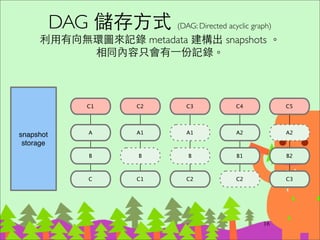













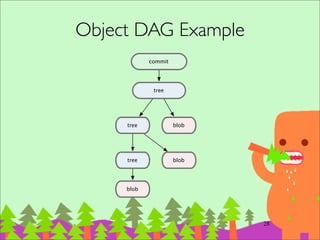


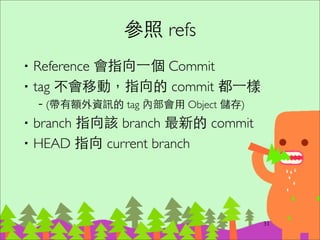


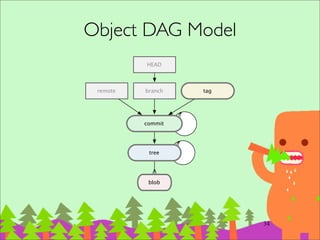






















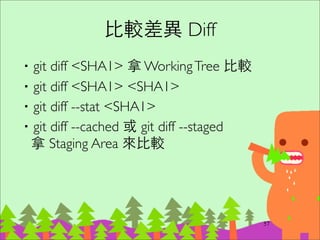


















![以 GitHub Repository 為例
建⽴立⼀一個專案!
‧產⽣生 SSH Key
–ssh-keygen -t rsa -C "your_email@youremail.com"
‧⾄至 Github 開⼀一個專案
‧git remote add origin git@github.com:your_account/
sandbox.git
‧git push -u origin master
‧之後只需要 git push
–出現 ![rejected] 表⽰示需要先做 git pull
91](https://image.slidesharecdn.com/git-ihower-120719095801-phpapp02/85/Git-Tutorial-91-320.jpg)



![Push 將 Commit 送出去
‧git push 或 git push origin master
–實際的作⽤用是將本地端的 master branch 與遠端
的 master branch 作 fast-forward 合併
‧如果出現 [rejected] 錯誤的話,表⽰示你必須
先作 pull。
‧預設不會 push tags 資訊
–git push --tags
95](https://image.slidesharecdn.com/git-ihower-120719095801-phpapp02/85/Git-Tutorial-95-320.jpg)




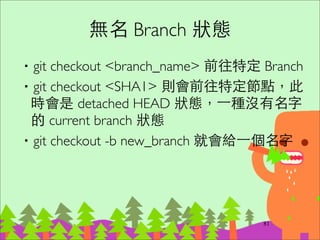



















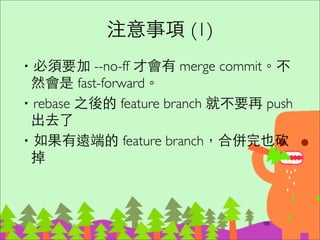




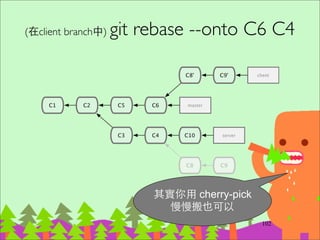




























![bash-completion
‧http://bash-completion.alioth.debian.org/
‧Install via Homebrew (Mac only)
–brew install bash-completion
–cp /usr/local/etc/bash_completion.d/git-
completion.bash ~/.git-bash-completion.sh
–編輯 ~/.bash_profile 加⼊入
[ -f ~/.git-bash-completion.sh ] && . ~/.git-bash-
completion.sh
154](https://image.slidesharecdn.com/git-ihower-120719095801-phpapp02/85/Git-Tutorial-154-320.jpg)
![Useful alias
編輯 ~/.gitconfig
155
[alias]
co = checkout
ci = commit
st = status
br = branch -v
rt = reset --hard
unstage = reset HEAD
uncommit = reset --soft HEAD^
l = log --pretty=oneline --abbrev-commit --graph --
decorate
amend = commit --amend
who = shortlog -n -s --no-merges
g = grep -n --color -E
cp = cherry-pick -x
nb = checkout -b](https://image.slidesharecdn.com/git-ihower-120719095801-phpapp02/85/Git-Tutorial-155-320.jpg)
![Useful alias
編輯 ~/.gitconfig
156
[alias]
!
# 'git add -u' 只包含刪除的檔案,不包含新增檔案
# 'git add .' 包含修改和新增的檔案,但是不包含刪除
# 'git addall' 通通加到 staging
!
addall = !sh -c 'git add . && git add -u'](https://image.slidesharecdn.com/git-ihower-120719095801-phpapp02/85/Git-Tutorial-156-320.jpg)
























